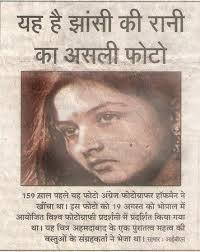Rani Lakshmi Bai, who was also known as Jhansi Ki Rani, was one of the leading figures of the Indian Rebellion of 1857. She became the shining symbol of resistance to British rule in India.
If we talk about her early life,she was originally named Manikarnika and nicknamed Manu. She was born on 19 November 1835 at Kashi (Varanasi) to a Maharashtrian Marathi Karhade Brahmin family, the daughter of Moropant Tambe and Bhagirathibai Tambe. She lost her mother at the age of four, and was educated at home. Her father, Moropant Tambe, worked at the court of Peshwa at Bithur, who brought her up like his own daughter, and called her “Chhabili” because of her light-heartedness.
In March 1854, she was given a pension of 60,000 rupees and ordered to leave the palace at the Jhansi fort.
While unsavourary developments were taking place, on May 10, 1857 the Indian Rebellion started in Meerut. The unrest began to spread throughout India and, in May 1857, the Rebellion erupted in numerous pockets across the northern subcontinent. During this chaotic time, the British were forced to focus their attentions elsewhere, and Lakshmi Bai was essentially left to rule Jhansi alone. During this time, she was able to swiftly and efficiently lead her troops against skirmishes breaking out in Jhansi. Through this leadership Lakshmi Bai was able to keep Jhansi relatively calm and peaceful in the midst of the Empire’s unrest. For example, she conducted the haldi-kumkum ceremony with great pomp for all the women of Jhansi to provide assurance to her subjects and to convince them that Jhansi was under no threat of an attack.
She had been hesitant to rebel against the British. Her hesitation finally ended when British troops arrived under Sir Hugh Rose and laid siege to Jhansi on 23 March 1858. She rallied her troops around her and fought fiercely against the British. An army of 20,000, headed by the rebel leader Tatya Tope, was sent to relieve Jhansi and to take Laxmi Bai to freedom. However, the British, though numbering only 1,540 in the field so as not to break the siege, were better trained and disciplined than the raw recruits, and these inexperienced soldiers turned and fled shortly after the British began to attack on 31st March. Lakshmi Bai’s forces could not hold out and three days later the British were able to breach the city walls and capture the city. Lakshmi Bai escaped by jumping from the wall at night and fled from her city, surrounded by her guards, many of whom were women from her military.
Along with the young Anand Rao, the Rani decamped to Kalpi along with her forces where she joined other rebel forces, including those of Tatya Tope. The Rani and Tatya Tope moved on to Gwalior, where the combined rebel forces defeated the army of the Maharaja of Gwalior after his armies deserted the rebel forces. They then occupied a strategic fort at Gwalior. However, on either the 17th or 18th of June 1858, while battling in full warrior regalia against the 8th King’s Royal Irish Hussars in Kotah-ki Serai near the Phool Bagh area of Gwalior, she died. The British captured Gwalior three days later. In the British report of the battle, General Hugh Rose commented that the Rani, “remarkable for her beauty, cleverness and perseverance”, had been “the most dangerous of all the rebel leaders”.
Rani Lakshmi Bai became a national heroine and was seen as the epitome of female bravery in India. When Subhas Chandra Bose’s Indian National Army created its first female unit, it was named after her.

Leave a comment